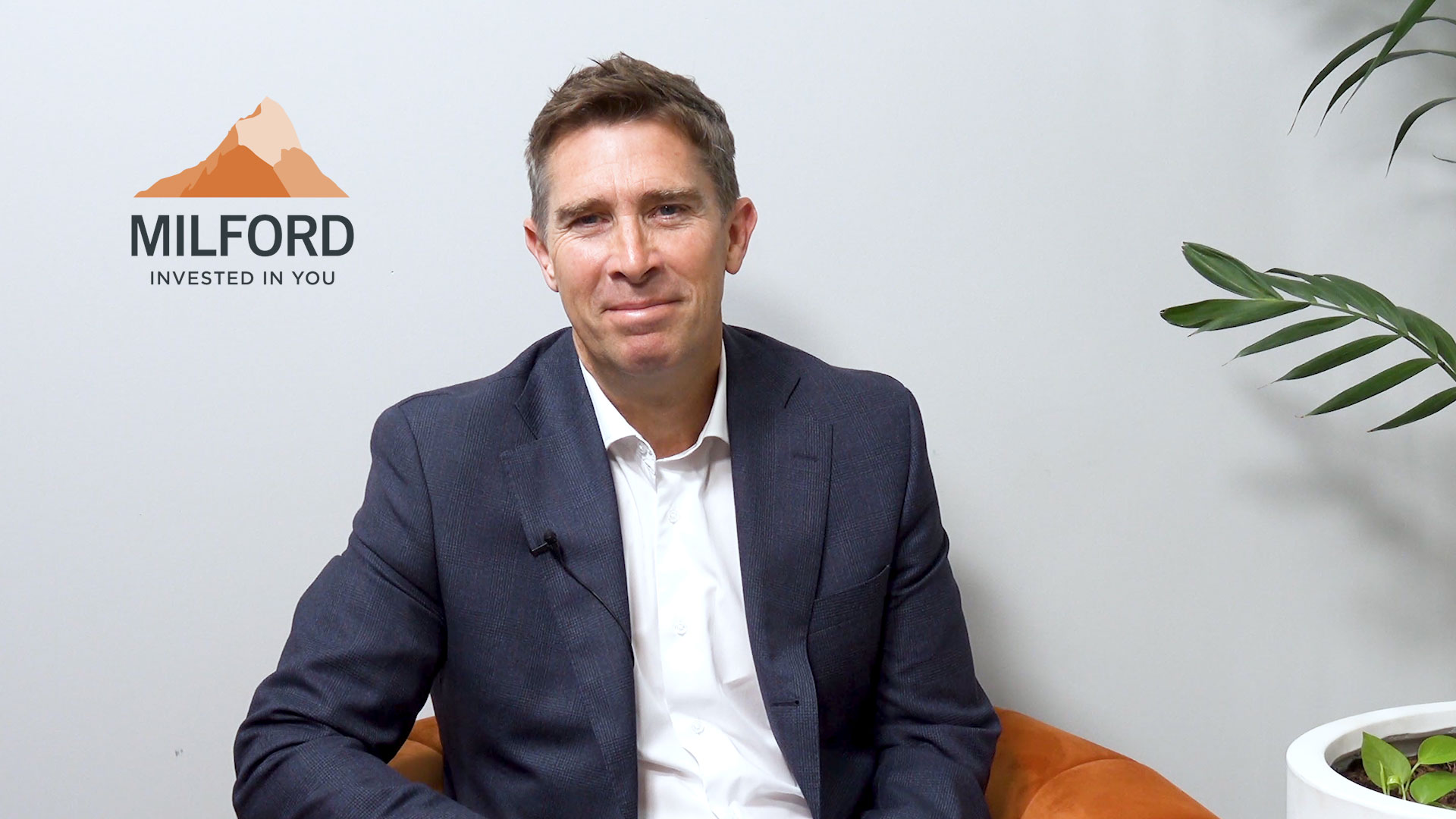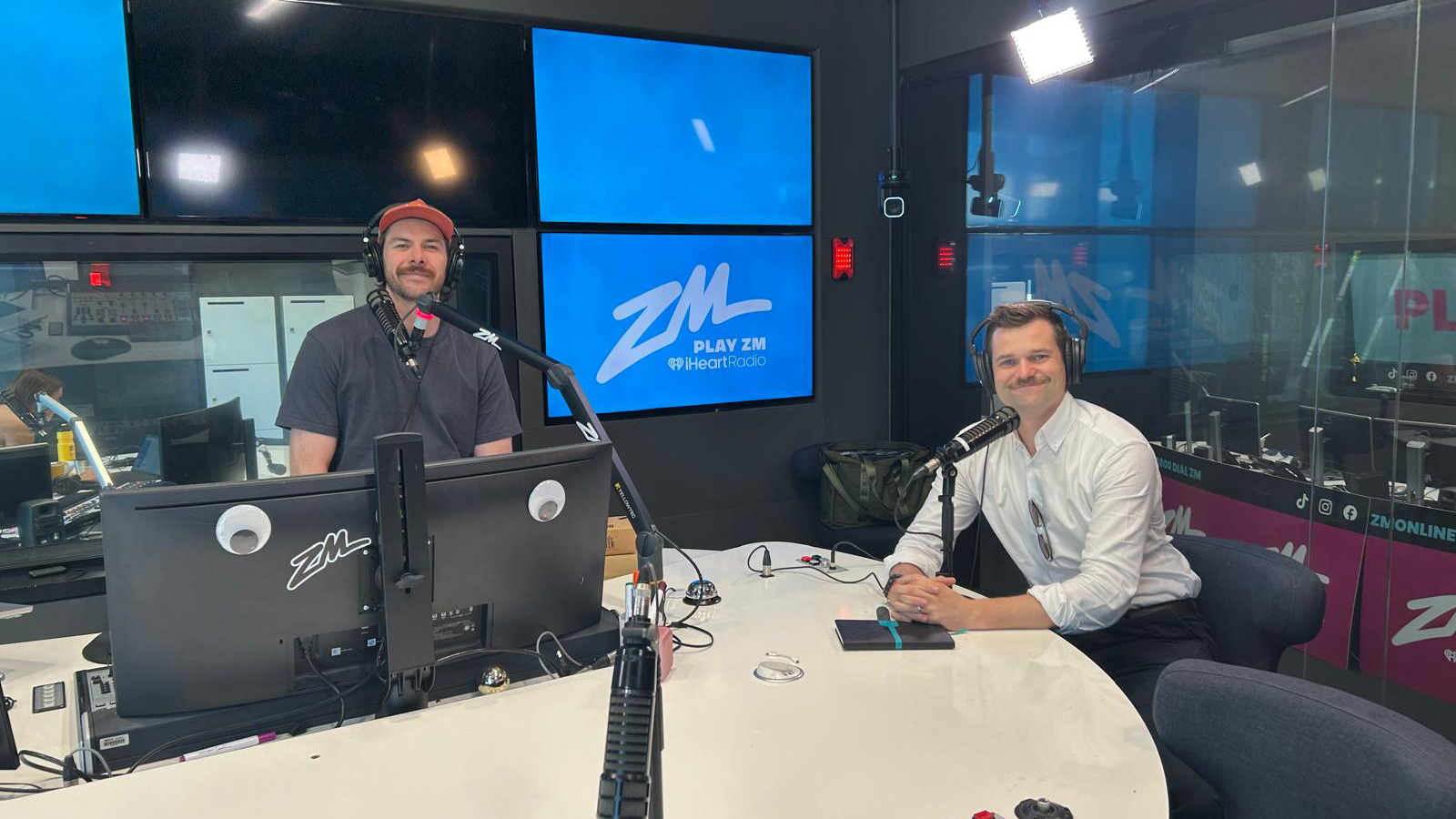In this week’s episode, Milford Portfolio Manager Jono Windust takes a deep dive into the Active Growth Fund. He outlines Milford’s strategy, and the reasons the Fund has outperformed its benchmark (after fees and before tax) over 10 years (as @30 September 2024).
Listen.
Listen to the podcast on your favourite platform:
Read.
Bridge talks Business: 22 October 2024
Episode Transcript
Ryan Bridge
Hey, guys, welcome to episode 11 of Bridge Talks Business with Milford. This week, we’re going behind the scenes of an award-winning KiwiSaver fund that’s making headlines for all the right reasons.
First, though, here’s your top five business bits from the past week.
1. The genie is finally back in the bottle. Quarter three inflation revealing for the first time since 2021, inflation is back in the Reserve Bank’s target range. All eyes now on the final RBNZ meeting at the end of November for more rate cuts.
2. We are not alone. Inflation data is softening elsewhere as well across Canada, the UK and Europe.
3. China’s growth picture is stabilising thanks to stimulus measures, but also economic data released last week, not as weak as feared.
4. Markets are picking Trump for the win. They’re starting to price an increased chance that Donald Trump will win the US election. There is still plenty of things that could change over the next few weeks, though.
5. We’re watching company quarterly profits this week. As reporting season picks up a pace, it’ll give us a read on how companies are faring and likely generating some outsized stock moves as investors digest surprises, both negative and positive.
You’ve probably heard a lot about Milford in the media over the past few months. Not only did they take out three Canstar Awards, including Canstar’s KiwiSaver Provider of the Year award for 2024, fifth year on the trot, but they also made headlines for their returns.
Just a quick note, this segment is informational only and should not be considered financial advice. Today, I’m joined by the guy who manages this Fund, Jono Windust, Portfolio Manager at Milford. Jono, welcome to the show.
Jono Windust
It’s good to be here.
Ryan Bridge
I’ve been trying to get you on the show for a long time.
Jono Windust
Oh, well we’re here.
Ryan Bridge
Let’s talk about the Fund.
Jono Windust
Yeah.
Ryan Bridge
In terms of value, how big is it? What numbers are we talking?
Jono Windust
Yeah, so there’s two ways to access the Active Growth Fund. You can get in via KiwiSaver and that’s about $6 billion. And you can get in via the unit trust, which is about $4 billion. So $10 billion in total.
Ryan Bridge
Wow. That’s a lot of responsibility.
Jono Windust
Yeah, it is. But we focus on what we’re doing, and stick to the process and the results come out the other end.
Ryan Bridge
The results really have spoken for themselves. You must be proud of those results, are you?
Jono Windust
We’re proud of the results. I mean, we’re a competitive bunch, so we’re always trying to do better. But we are proud and you’ve got to look back and say, hey, we’ve done well and take it. Otherwise, you’re just going every day over and over again. So, it’s good to look back and say, yeah, I’ve done a good job.
Ryan Bridge
Can we talk about, because I want to get into more about you and how you’ve got to this position. But I’m interested in the day-to-day, how big a trades are you doing on a day-to-day basis and how are they done?
Jono Windust
Every day is different. Some days we’ll be more active than others and every asset class is different. But generally, the Active Growth Fund, we get to invest across New Zealand, Australia, fixed income, currency. So in currencies, we might deal $200 or $300 million a day – some days – and then we won’t deal for a week. In New Zealand, shares are smaller markets, so we’re probably doing $10 million tickets. Global shares are really liquid. So we can trade a percent of the Fund in one go, which is more like $100 million. So yeah, it really depends. And every day is different. If nothing’s going on, we’re not going to be doing anything in the Fund.
Ryan Bridge
With a Fund like this, or I should say Funds like this, what is the strategy? How do you balance that, the risk and the exposure versus the higher returns that a Fund like that might expect?
Jono Windust
It’s all about risk and reward. And that’s what we’re trying to do. We’re trying to balance that risk and reward. Active Growth Fund is what they call a growth fund, which is about 80% shares, 20% fixed income. And what we’re trying to do is bring together a whole lot of investments. So we’ll have over 100 investments in the Fund that have all got good risk rewards. And then some are going to work, some are not going to work. But if you’ve done your work over time, the probability is you’ll be successful. So it’s balancing that risk reward continuously, basically. But that’s what we’re trying to do. A portfolio of good risk reward opportunities.
Ryan Bridge
How do you assess the risk? Whose job is that?
Jono Windust
Yeah, again, that’s my job. So it’s a growth fund. So we’re allowed to take some risk. But we’re really saying, are we being rewarded for that risk? So, if something’s high risk, then it’s got to be high return. If it’s low risk, we’re happy to accept a lower return. And again, it’s combining all of those investments together to generate a portfolio that’s delivering a good return for the risk that it’s taking.
Ryan Bridge
With an Active Growth Fund, is there a minimum that you have to earn? Or a percentage you have to hit? Or is it just you allow yourself more risk.
Jono Windust
Generally on shares, you’re trying to get a premium over a government bond. So the government bond yield at the moment, is around about 4%. So you want to earn 4% to 6% over that when you’re investing into a share. Otherwise, we can invest in the government bond. We can invest into the cash. The Active Growth Fund target is 10% over time. And we’ve been able to do that over long periods of time and consistently do that. Consistently, if you’re measuring us over longer term time periods, from day to day, shares are up and down. But that’s the goal. Some years we’ll do better. Some years we’ll do worse. But that’s the goal over the medium term.
Ryan Bridge
So you mentioned that you’re investing in different asset classes. What other types of asset classes you’re investing in, what’s the difference between them?
Jono Windust
So the two big asset classes are shares, which you’re trying to get growth out of, and fixed income, which is there to provide more steady income-type returns. And then you can divide shares up into New Zealand, Australia, global. So the Fund can really decide where we want to go. It’s got quite a flexible mandate. So if we can’t see value in New Zealand shares, we can go to Australian shares. If we can’t see value in Australia, we can go to the US. So those are the asset classes and the options that the Fund has got.
Ryan Bridge
So when you say shares, you’re talking about buying shares at a certain price and then hopefully selling them at a higher price. What is fixed income?
Jono Windust
Yeah.
Ryan Bridge
What is fixed income?
Jono Windust
Fixed income is like a government bond or a bond that a bank has issued. It’s like a term deposit, but generally we can decide if we think rates are going to fall, we’ll try and invest in longer dated fixed income or bonds. We might invest for seven years. And we can make money out of that too. So if we can lock in rates when rates are high and invest in a high rate for seven years, that’s obviously better if rates fall. So we can make capital gains on those as well. So fixed income is a useful asset class.
Ryan Bridge
And for a Fund like this, you said it was an 80-20 split. So 80 shares, 20 fixed?
Jono Windust
That’s where we’ll average over time, but we have a lot of flexibility, as I said. So if we’re a bit worried about the share market, we’ll reduce the allocation to shares and we’ll increase the allocation to fixed income or cash. We’ve got a lot of levers, I guess, moving between those different asset classes, depending on the outlook and our risk reward prospects of those asset classes.
Ryan Bridge
I know as a journalist, I’m constantly looking at the news. I’m constantly looking for updates because that’s what we do. I imagine it’s a similar story for you. Are you constantly just searching everywhere for everything, trying to predict what’s happening?
Jono Windust
We get a lot of news thrown at us. Two main types of news. It’s really economic news – releases from statistics departments, what’s inflation, what’s retail sales, for example. We’re using that to try and form a view of where the economy is going to go. And then company news – company reporting, company announcements. In the US, every quarter companies are coming out with a result. We’re in that reporting period at the moment. So those are the main two types of news. And then there’s a lot of noise. So there’s a lot of stuff to ignore, a lot of hype to ignore.
Ryan Bridge
Yeah, mostly the stuff that we generate sometimes. What’s the biggest call you’ve made in your career so far?
Jono Windust
That’s a hard question because I’ve been doing this a while. And yeah, you make a lot of calls really. Some go well, some don’t go well. We’ve had some good company successes over time. Restaurant Brands was an early one for Milford. We took a big investment below $1. That subsequently went above $10. So that was a great call. That was a big stake in the company and a big bet for Milford at the time. But as we’ve got bigger, we’re just trying to create a number of calls into that portfolio. At the moment, we’ve got a couple of big calls. One of them is on the currency. So we’ve taken a negative view on the New Zealand dollar and a positive view on the US dollar, reflecting the strengths of the economies and the relative interest rate differentials. So that’s working this month – that’s quite a big call at the moment.
Ryan Bridge
And how quickly can you change tack? If you’ve got a strategy, you’ve been employing a strategy, it’s been working, you’ve had success, but then you’re reading the tea leaves or I’m sure it’s more technical than that. How quickly can you change tack and change strategy?
Jono Windust
Yeah, very quickly. And that’s part of the skill, I guess, when you’ve got to realise that you’re wrong and you’ve got to say, “Okay, let’s get me out of this. Let’s go back to basics.” Or, yeah, sometimes you’ve got to decide to keep running. But in the big asset classes like currency, we can change our positions really, really quickly. The big global markets, we can change them really, really quickly with futures and options and derivatives. We’re always testing is the strategy right? Are we still on the right path?
Ryan Bridge
Do you physically push the buttons that do the trades? Or do you have dealers that do that?
Jono Windust
We’ve got a team of four dealers. We’re entering into an order management system and that sends them to the dealers. And the dealers will either ring up a broker or send those directly, sort of electronically to the brokers. I guess you are pushing a button, a buy button or a sell button.
Ryan Bridge
If it’s as intense as it sounds to me, how do you unwind? What do you do to relax and tune out from it?
Jono Windust
I guess just get out and do something active. So ride a bike, play golf, play cricket, play tennis. It gets your mind away from it. I find golf’s great. You go and play golf. You’re out there for three, four hours and you haven’t thought about the markets at all. It’s a great way to unwind, I think.
Ryan Bridge
Until you come back and you’re like “I’m not going to miss this”.
Jono Windust
Yeah, it’s almost – not a drug – but we’re following the markets. So yeah, you want to get away for a while, but you’re quite happy to get back into it as well.
Ryan Bridge
Do you love doing it?
Jono Windust
Yeah it’s great. It’s a challenge. There’s always something different happening. There’s always a different company to look at. Economies are going different ways. There’s always opportunities. I really do enjoy it.
Ryan Bridge
I suppose it’s varied and interesting and your sources of information you mentioned are wide and varied too. You’ve got to be across geopolitics and all sorts of different stuff.
Jono Windust
Yes, that variety is great. I guess part of the skill is what matters, what doesn’t, and where you’re going to focus your effort to get the best return for the amount of time that you’re spending looking at it.
Ryan Bridge
What’s your background? Because you said you’ve been at Milford for 15 years. Where were you before here?
Jono Windust
I studied finance at Waikato. Then I went down to Wellington, and worked for the Dairy Board, which is now Fonterra, doing foreign exchange. That was really good, really fun buy and sell. It was in the Asian crisis, so there was a lot of stuff going on. That was a good learning experience. Came up to Auckland for a couple of years and worked for a couple of fund managers up here before going over to London. I spent seven years in London, which was great experience because the markets over there are just so much bigger and there’s so much going on.
Ryan Bridge
You worked for a big pension fund over there, right?
Jono Windust
I worked for an asset manager that managed the funds of a big pension fund. It was the NatWest bank pension fund. So, yeah, that was great. In New Zealand you’re managing small amounts of money, over there you’re managing billions. And now we’re getting to billions here. So, yeah, I think it set me up quite well.
Ryan Bridge
Yeah, I suppose going over there, having that experience with huge numbers and huge risk would build your confidence in that space, I guess.
Jono Windust
Yeah, you just learn. I think if you just stay in New Zealand, you’re only going to see things a certain way, getting out and travelling and broadening those experiences, and different asset classes has been great. We’ve just got a lot more positive on the UK market more recently. So it’s great to get back there and start looking at the companies over there again.
Ryan Bridge
What’s behind the positivity?
Jono Windust
I guess there’s so much negativity that’s been built into the UK. They’ve sort of had Brexit and change of governments, Covid and inflation. So things have got so bad.
Ryan Bridge
They haven’t made it easier on themselves.
Jono Windust
No, so it’s been so bad that everyone is quite pessimistic. So we’re getting to buy good quality companies at reasonable valuations. So, yeah, we think it’s a pretty good time risk reward.
Ryan Bridge
Jono, thanks very much for talking to me.
Jono Windust
No problem. Very good to meet you.
Ryan Bridge
Really appreciate it. That was Jono Windust, Portfolio Manager at Milford, and for anyone who wants more information on Milford’s active growth funds, check out the website. Next week, Episode 12 as we cruise into November with the US election and the final Reserve Bank decision due at the end of the month. Don’t forget to like, follow, subscribe this podcast wherever you’re listening to it. We appreciate it. See you next week.
Missed last week’s episode? Don’t worry! Click here to catch up now.


